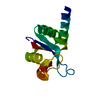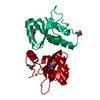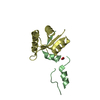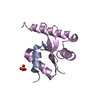+ Open data
Open data
- Basic information
Basic information
| Entry | Database: PDB / ID: 2ml9 | ||||||
|---|---|---|---|---|---|---|---|
| Title | Solution structure of YSCUCN in a micellar complex with SDS | ||||||
 Components Components | Yop proteins translocation protein U | ||||||
 Keywords Keywords | MEMBRANE PROTEIN / YERSINIA / TYPE III SECRETION SYSTEM / YSCU / SECRETION SPECIFICITY / SODIUM DODECYL SULFATE | ||||||
| Function / homology | Type III exporter system, secretion apparatus protein BsaZ / Type III secretion system substrate exporter / Type III secretion system substrate exporter, C-terminal / FlhB HrpN YscU SpaS Family / protein secretion / plasma membrane / Yop proteins translocation protein U Function and homology information Function and homology information | ||||||
| Biological species |  Yersinia pseudotuberculosis IP 32953 (bacteria) Yersinia pseudotuberculosis IP 32953 (bacteria) | ||||||
| Method | SOLUTION NMR / simulated annealing, torsion angle dynamics | ||||||
| Model details | lowest energy, model1 | ||||||
 Authors Authors | Weise, C.F. / Wolf-Watz, M. | ||||||
 Citation Citation |  Journal: Biophys.J. / Year: 2014 Journal: Biophys.J. / Year: 2014Title: Negatively charged lipid membranes promote a disorder-order transition in the Yersinia YscU protein. Authors: Weise, C.F. / Login, F.H. / Ho, O. / Grobner, G. / Wolf-Watz, H. / Wolf-Watz, M. | ||||||
| History |
|
- Structure visualization
Structure visualization
| Structure viewer | Molecule:  Molmil Molmil Jmol/JSmol Jmol/JSmol |
|---|
- Downloads & links
Downloads & links
- Download
Download
| PDBx/mmCIF format |  2ml9.cif.gz 2ml9.cif.gz | 380.3 KB | Display |  PDBx/mmCIF format PDBx/mmCIF format |
|---|---|---|---|---|
| PDB format |  pdb2ml9.ent.gz pdb2ml9.ent.gz | 322.2 KB | Display |  PDB format PDB format |
| PDBx/mmJSON format |  2ml9.json.gz 2ml9.json.gz | Tree view |  PDBx/mmJSON format PDBx/mmJSON format | |
| Others |  Other downloads Other downloads |
-Validation report
| Summary document |  2ml9_validation.pdf.gz 2ml9_validation.pdf.gz | 402.3 KB | Display |  wwPDB validaton report wwPDB validaton report |
|---|---|---|---|---|
| Full document |  2ml9_full_validation.pdf.gz 2ml9_full_validation.pdf.gz | 487.7 KB | Display | |
| Data in XML |  2ml9_validation.xml.gz 2ml9_validation.xml.gz | 21.4 KB | Display | |
| Data in CIF |  2ml9_validation.cif.gz 2ml9_validation.cif.gz | 33.3 KB | Display | |
| Arichive directory |  https://data.pdbj.org/pub/pdb/validation_reports/ml/2ml9 https://data.pdbj.org/pub/pdb/validation_reports/ml/2ml9 ftp://data.pdbj.org/pub/pdb/validation_reports/ml/2ml9 ftp://data.pdbj.org/pub/pdb/validation_reports/ml/2ml9 | HTTPS FTP |
-Related structure data
| Related structure data | |
|---|---|
| Similar structure data | |
| Other databases |
- Links
Links
- Assembly
Assembly
| Deposited unit | 
| |||||||||
|---|---|---|---|---|---|---|---|---|---|---|
| 1 |
| |||||||||
| NMR ensembles |
|
- Components
Components
| #1: Protein | Mass: 6832.867 Da / Num. of mol.: 1 / Fragment: UNP RESIDUES 211-263 Source method: isolated from a genetically manipulated source Source: (gene. exp.)  Yersinia pseudotuberculosis IP 32953 (bacteria) Yersinia pseudotuberculosis IP 32953 (bacteria)Gene: pYV0074, yscU / Production host:  |
|---|
-Experimental details
-Experiment
| Experiment | Method: SOLUTION NMR | ||||||||||||||||||||||||||||
|---|---|---|---|---|---|---|---|---|---|---|---|---|---|---|---|---|---|---|---|---|---|---|---|---|---|---|---|---|---|
| NMR experiment |
|
- Sample preparation
Sample preparation
| Details | Contents: 100 uM [U-99% 13C; U-99% 15N] protein-1, 30 mM sodium phosphate-2, 50 mM sodium chloride-3, 26 mM SDS-4, 92% H2O/8% D2O Solvent system: 92% H2O/8% D2O | ||||||||||||||||||||
|---|---|---|---|---|---|---|---|---|---|---|---|---|---|---|---|---|---|---|---|---|---|
| Sample |
| ||||||||||||||||||||
| Sample conditions | Ionic strength: 0.12 / pH: 6 / Pressure: ambient / Temperature: 310 K |
-NMR measurement
| NMR spectrometer | Type: Bruker Avance / Manufacturer: Bruker / Model: AVANCE / Field strength: 600 MHz |
|---|
- Processing
Processing
| NMR software |
| |||||||||||||||||||||
|---|---|---|---|---|---|---|---|---|---|---|---|---|---|---|---|---|---|---|---|---|---|---|
| Refinement | Method: simulated annealing, torsion angle dynamics / Software ordinal: 1 Details: SIMULATED ANNEALING FROM EXTENDED STRUCTURE, MINIMIZATION IN TORSION ANGLE/CARTESIAN SPACE | |||||||||||||||||||||
| NMR constraints | NOE constraints total: 203 / NOE intraresidue total count: 39 / NOE long range total count: 0 / NOE medium range total count: 45 / NOE sequential total count: 119 / Protein chi angle constraints total count: 0 / Protein other angle constraints total count: 0 / Protein phi angle constraints total count: 80 / Protein psi angle constraints total count: 80 | |||||||||||||||||||||
| NMR representative | Selection criteria: lowest energy | |||||||||||||||||||||
| NMR ensemble | Average torsion angle constraint violation: 0 ° Conformer selection criteria: structures with least restraint violations, followed by selection by lowest energy Conformers calculated total number: 100 / Conformers submitted total number: 20 / Maximum distance constraint violation: 0.554 Å / Maximum lower distance constraint violation: 0.073 Å / Maximum torsion angle constraint violation: 2.29 ° / Maximum upper distance constraint violation: 0 Å / Representative conformer: 1 | |||||||||||||||||||||
| NMR ensemble rms | Dihedral angles rms dev error: 0.53 ° / Distance rms dev: 0 Å / Distance rms dev error: 0 Å |
 Movie
Movie Controller
Controller










 PDBj
PDBj HSQC
HSQC